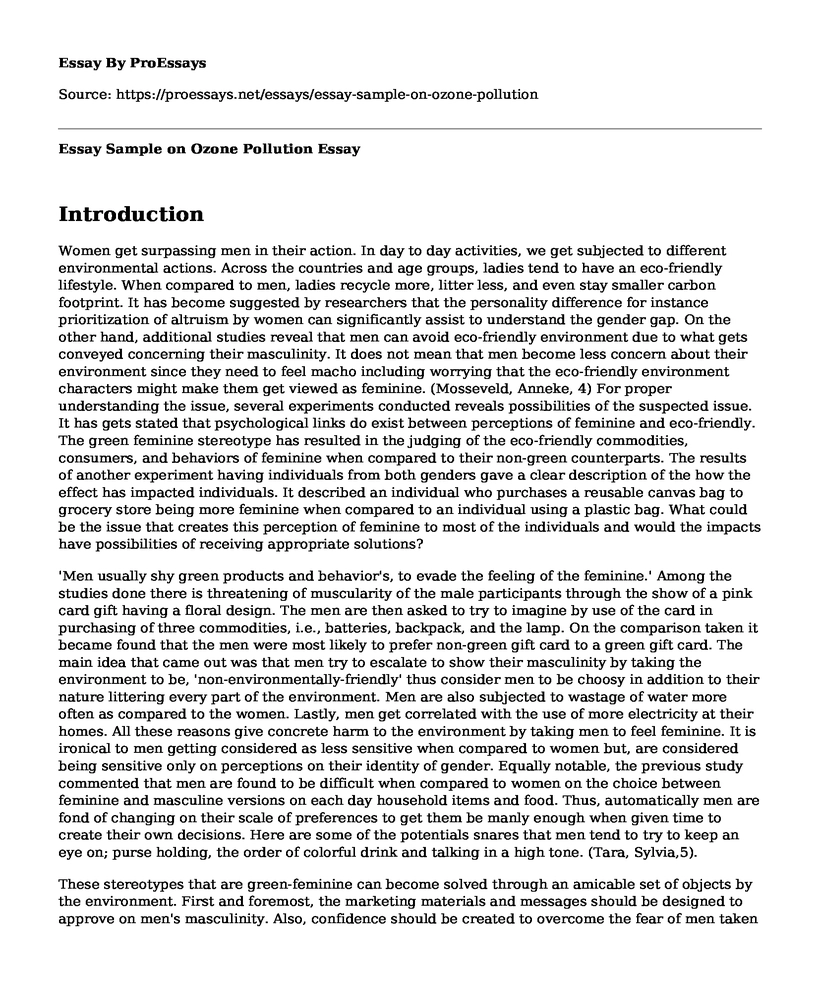Introduction
Women get surpassing men in their action. In day to day activities, we get subjected to different environmental actions. Across the countries and age groups, ladies tend to have an eco-friendly lifestyle. When compared to men, ladies recycle more, litter less, and even stay smaller carbon footprint. It has become suggested by researchers that the personality difference for instance prioritization of altruism by women can significantly assist to understand the gender gap. On the other hand, additional studies reveal that men can avoid eco-friendly environment due to what gets conveyed concerning their masculinity. It does not mean that men become less concern about their environment since they need to feel macho including worrying that the eco-friendly environment characters might make them get viewed as feminine. (Mosseveld, Anneke, 4) For proper understanding the issue, several experiments conducted reveals possibilities of the suspected issue. It has gets stated that psychological links do exist between perceptions of feminine and eco-friendly. The green feminine stereotype has resulted in the judging of the eco-friendly commodities, consumers, and behaviors of feminine when compared to their non-green counterparts. The results of another experiment having individuals from both genders gave a clear description of the how the effect has impacted individuals. It described an individual who purchases a reusable canvas bag to grocery store being more feminine when compared to an individual using a plastic bag. What could be the issue that creates this perception of feminine to most of the individuals and would the impacts have possibilities of receiving appropriate solutions?
'Men usually shy green products and behavior's, to evade the feeling of the feminine.' Among the studies done there is threatening of muscularity of the male participants through the show of a pink card gift having a floral design. The men are then asked to try to imagine by use of the card in purchasing of three commodities, i.e., batteries, backpack, and the lamp. On the comparison taken it became found that the men were most likely to prefer non-green gift card to a green gift card. The main idea that came out was that men try to escalate to show their masculinity by taking the environment to be, 'non-environmentally-friendly' thus consider men to be choosy in addition to their nature littering every part of the environment. Men are also subjected to wastage of water more often as compared to the women. Lastly, men get correlated with the use of more electricity at their homes. All these reasons give concrete harm to the environment by taking men to feel feminine. It is ironical to men getting considered as less sensitive when compared to women but, are considered being sensitive only on perceptions on their identity of gender. Equally notable, the previous study commented that men are found to be difficult when compared to women on the choice between feminine and masculine versions on each day household items and food. Thus, automatically men are fond of changing on their scale of preferences to get them be manly enough when given time to create their own decisions. Here are some of the potentials snares that men tend to try to keep an eye on; purse holding, the order of colorful drink and talking in a high tone. (Tara, Sylvia,5).
These stereotypes that are green-feminine can become solved through an amicable set of objects by the environment. First and foremost, the marketing materials and messages should be designed to approve on men's masculinity. Also, confidence should be created to overcome the fear of men taken as feminine when undertaking the so-called, 'green behavior's. One of the experiments taken showed that the men receiving feedback on the affirmation of their masculinity get most interest in purchasing a version that is eco-friendly for cleaning purposes. Surety in men is found in those who consider their manhood to be more of green than non-green. Men are taken to be environmental- friendly when colors, images, and words get labeled in branding. The men take more products with logos of masculine nature 'Wilderness Rangers' as compared to traditional logos with 'Friends of Nature.' In China research on BMW cars, men are found to get much interest on a hybrid vehicle on seeing a feature and view of masculine terms on the model's description as compared to views and features that become traditionally printed.
Conclusion
In summary, the paper has elaborated various findings which are related to the arising issue. The reasons given for the environmental action gets explained with the appropriate examples. The remaining question is whether the issues would get passed to the incoming generations. With the solution given, the issue gets an address in a better way. The findings stated the way green feminine stereotype restrain men from implementing the eco- friendly actions. Notably, the findings also suggested that the masculine branding and the masculine affirmation may become efficient in reducing the gap of gender in the environment. The men would feel manly, and there is the likelihood of them going green.
Work Cited
Mosseveld, Anneke. The Australian Army Uniform and the Government Clothing Factory: Innovation in the Twentieth Century. , 2018. Internet resource.
Tara, Sylvia. The Secret Life of Fat: The Science Behind the Body's Least Understood Organ and What It Means for you, 2017. Print.
Cite this page
Essay Sample on Ozone Pollution. (2022, Apr 16). Retrieved from https://proessays.net/essays/essay-sample-on-ozone-pollution
If you are the original author of this essay and no longer wish to have it published on the ProEssays website, please click below to request its removal:
- Relationship Between Environment and Cancers Paper Example
- Genetically Modified Food Technologies Essay Example
- Essay on Climatic Change: What IDRC Can Contribute?
- Living in the Country vs. The City Essay
- Essay Example on Bioenergy: Harnessing Solar Energy Through Biomass
- Essay Sample on Australia's 2019-2020 Bushfire Crisis: A Tragic Tale
- Paper Example on Public Health Crisis: Urgent Action Needed to Restore Environment







